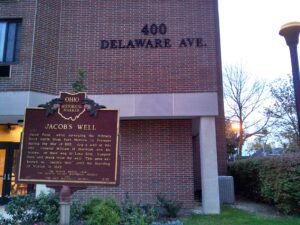, OH
Boyhood home (1872-1881) of Warren G. Harding, 29th president of the United States. In a Caledonia printing shop owned by his father, Dr. George Tryon Harding, Warren learned the fundamentals of the printing trade which inspired his interest in a journalism career.
, OH
Jacob Foos, while surveying the Military Road north from Fort Morrow to Fremont during the War of 1812, dug a well at this site. General William H. Harrison and his troops, on their way to Lake Erie, camped here and drank from the well. This area was known as “Jacob’s Well” until the founding of Marion in 1822.
, OH
This grass land, extending one mile east between the road and the railway, is one of the few surviving remnants of the once extensive prairies that were part of pioneer Marion County. This strip, preserved by chance when the railway and road were constructed side by side, contains more than 75 species of significant prairie grasses and flowers.
, OH
Was born on this site Nov. 20, 1884. He graduated from Marion High School in 1901, Princeton University in 1905, and from Union Theological Seminary. Thomas, a clergyman, and the son of Marion’s Presbyterian minister, was a tireless worker for social security, civil rights, and human justice. Six time Socialist Party presidential candidate, he was a leader in the effort toward disarmament and world peace. He died Dec. 19, 1968, in Huntington, N.Y.
, OH
This is Marion County’s fourth courthouse and the second at this site. The cornerstone was laid on July 4, 1884. Costing $115, 00, it was completed in 1885 by contractors Leffler and Bland. In 1973 the courthouse was placed on the National Register of Historic Places. In 1975 the interior was remodeled at a cost of over $900,000.
, OH
The Oorang Indian football team was founded by LaRue native Walter Lingo (1890-1966), owner of the Oorang Airedale Dog Kennels. The team, comprised of Native American Indians, played in the National Football League (NFL) in 1922-23. The star player and coach was Jim Thorpe (1887-1953), a Sac and Fox Indian. Thorpe gained international fame as a two-time gold medal winner (decathlon and pentathlon) in the 1912 Olympics and was acclaimed as the “World’s Greatest Athlete.” The team gave LaRue the distinction of being the smallest community ever to have an NFL franchise.
, OH
The U.S. Army built a two-story blockhouse on a nearby hill during the War of 1812. The blockhouse was one of a series of such structures erected along the Greenville Treaty line to guard against Native Americans who supported the British during the conflict. After the war, Daniel Markley, one of Green Camp Township’s first white inhabitants, settled near the blockhouse. In 1963, the graves of twenty-five prehistoric Glacial Kame Indians and six white settlers were discovered near the blockhouse site. Seventeen War of 1812 veterans and eight others were also buried there. These bodies were subsequently removed and reinterred at Green Camp Cemetery. An abandoned right-of-way of the Erie Railroad, Dayton line, also passes through the area. Prairie grasses that once dominated parts of Marion County can still be found in the vicinity.
, OH
During the early months of World War II, ordinary citizens as well as soldiers made enormous sacrifices for the war effort. In March 1942 the War Department announced plans to build a 13,000-acre munitions manufacturing complex northeast of Marion. Using the power of eminent domain, the U.S. Government purchased the homes and farms of 126 families in the Likens Chapel community. Given only two months to vacate their property, many displaced farmers found the government-appraised values for their land inadequate for buying similar farms elsewhere and the growing season too advanced to plant new crops. (continued on other side)









